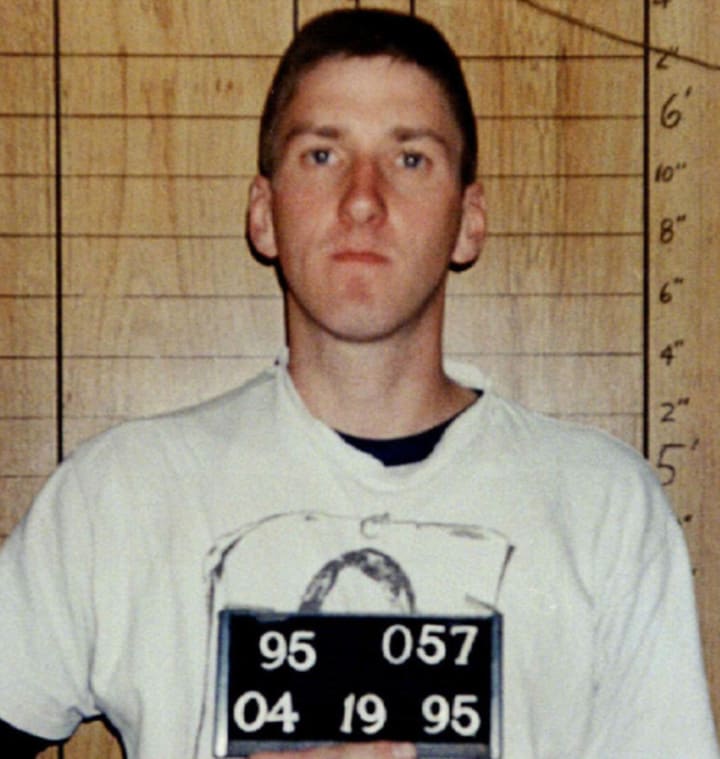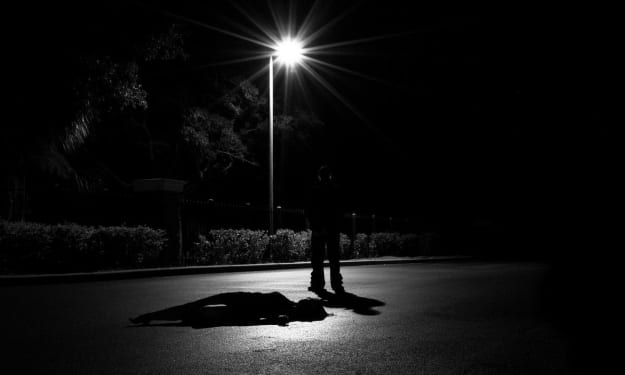Why You Should Only Commit One Crime At A Time
Learn from these criminals; don't let greed get the best of you.

As we all know, multitasking is overrated. So, if you plan on becoming a career criminal, it's always best to keep it simple and only commit one crime at a time.
After all, quality is better than quantity.
Therefore, even if you think of yourself as a criminal genius, you should never try to steal a car, rob two banks, and murder five people in one day.
If you are still unconvinced, let's look at some real-life criminals who learned this lesson the hard way.
Don't leave home without your license plate!
In the summer of 1993, two police officers patrolling Long Island's Southern State Parkway decided to stop a 1984 tan Mazda B2000 pickup. Was it because the driver was a serial killer with a dead woman in the truck? Nope, but that didn't help things. Police officers initially targeted Joel Rifkin for one simple reason: his vehicle was missing a license plate.
Perhaps knowing that things wouldn't end well for him, Joel decided that instead of pulling over for the cops, he would take the scenic route. Unfortunately for him, his road trip would end roughly 20 miles later when he ploughed into a utility pole on Old Country Road in Mineola, New York.
Eventually, it would come to light that Joel had killed 17 women between 1989 and 1993. Like many other serial killers, Joel's preferred targets were sex workers. Joel would hire a sex worker and have sex with them before strangling or bludging them to death. Once dead, Joel often took the extreme step of dismembering and scattering his victims' bodies to hide their identities.
Let's jump forward a couple of years to 19 April 1995.
An Oklahoma Highway Patrol trooper, Charlie Hanger, was on duty on this sunny spring day when he saw a rusty, yellow 1977 Mercury Marquis travelling north on Interstate 35 without a license plate.
When the patrol trooper pulled the car over, he encountered a well-groomed young man behind the wheel. The driver, a 26-year-old man, was dressed in military boots, a T-shirt with a picture of Abraham Lincoln on it, and a windbreaker. I'm assuming he was also wearing pants.
As was standard procedure then, Hanger ordered the driver out of the car. Once outside, Hanger informed the motorist that he had stopped him for not having a license plate.
The patrol trooper began questioning the driver and asked to see the car's bill of sale and insurance information. Neither was in the driver's possession. Things were not looking good for the driver. Still, it managed to get even worse when the driver informed the ever-sceptical Hanger that he was driving across multiple states because he was relocating to Arkansas and needed to bring more of his possessions with him. The car, however, lacked a suitcase and a change of clothing.
Sensing that something definitely didn't smell right; Hanger asked to see the man's driver's license. The driver reached into his pocket and brought out a Michigan license bearing the name Timothy James McVeigh.

However, when McVeigh reached for his license, his windbreaker tightened, allowing Hanger to see the outline of a gun underneath his jacket. In those days, it was against the law in Oklahoma to be armed and concealed.
The trooper arrested McVeigh for carrying a concealed weapon and transported him to the Noble County Jail, roughly 75 miles from the Alfred P. Murrah Federal Building in downtown Oklahoma City, Oklahoma. Only 90 minutes had passed since the bombing earlier that morning.
After that, the puzzle started to piece itself together. Timothy McVeigh would be put to death less than a decade later for perpetrating the 1995 Oklahoma City bombing that killed 168 people, including 19 children.

Sticking with the traffic theme, you want to ensure you are the epitome of a perfect driver if you're also a murderer.
Randy Kraft learned this lesson the hard way in the early morning of May 14, 1983. At 1:10 in the morning, two California Highway Patrol officers in the Mission Viejo area of Orange County spotted a Toyota Celica driving erratically on Interstate 5. After noticing an improper lane change, the police officers signalled for the car to stop, assuming the driver was impaired.
Kraft came to a stop and got out of the car, dropping the contents of a bottle of Moosehead Lager on the ground as he exited the vehicle.
Officer Michael Sterling observed Kraft's undone jeans and subjected him to a sobriety test, which Kraft subsequently failed.
At this point, Sterling's partner, Sergeant Howard, shifted his focus to the individual seated in the vehicle's front passenger seat. As Sergeant Howard approached the car, he observed a young guy in the passenger seat with his eyes closed and a jacket partly covering him. There were a few empty Moosehead beer bottles and an open bottle of Lorazepam pills at his feet.
Sgt. Howard tried to rouse the passenger, but he had already passed away.

Randy Kraft was arrested on the scene. After an intensive investigation, Kraft was unearthed as a serial killer and rapist. Kraft specifically went after gay males, whom he raped, photographed, and mutilated. Most of his victims were Marines, and toxicology reports on their bodies revealed excessive amounts of alcohol and tranquilizers, suggesting that they were murdered while under the influence.
In 1989, Randy Kraft was convicted of the murders of 16 men and sent to death row. He is still awaiting execution.
Don't forget your wallet
Have you ever forgotten to take your wallet to the store? If so, you'll know how aggravating it is to be at the checkout and reach into your bag, only to be met with an empty presence.
Many of us would return home to retrieve our wallets. Some of the more unscrupulous among us may do what Charles Ng did and apply the five-finger discount.
However, before applying your 100% discount, make sure you and your partner aren't sadistic serial killers and rapists. Unfortunately, Ng forgot that minor detail.
In June of 1985, Charles Ng and his literal partner in crime, Leonard Lake, drove to South City Lumber and Supply Co., a hardware store in San Francisco. They were at the store to pick up a vise tool.

And indeed, Ng picked up the vise tool and walked right out of the store with it. When a store clerk followed Ng outside, Ng threw the tool into the trunk of the car he had arrived in and fled the scene on foot.
Remaining at the scene, Lake tried to smooth things over and insisted on paying for the stolen vise tool. Unfortunately for Lake, the police had already been called, and Officer Danel Wright arrived on the scene a short time later.
Things weren't looking good for Leonard Lake. Granted, it probably didn't help that Lake was somehow associated with a thief, but it definitely didn't help that Lake was trying to pass off a missing man's driver's license as his own and had a prohibited silencer in his car. A car that was registered to another missing San Francisco resident named Paul Cosner.
The police quickly realized they weren't dealing with a simple case of theft.
Lake was soon apprehended on the scene and transported to the police station.
Recognizing the gravity of his predicament, Lake requested a glass of water and a piece of paper when there was a break in the questioning. Lake scribbled a brief message, revealing his and Ng's real names. He then ingested two cyanide tablets he had sewed into his lapel, which he usually carried about him for such an occasion. Lake fell into a coma and succumbed to the poison a few days later.
Like halftime during a Scooby-Doo episode, things soon went from bad to worse.
In due course, officers tracked down the fenced-in, secluded mountain cabin that Ng and Lake had called home in Wilseyville, California. Upon scouring the premises, they uncovered a plethora of evidence that the two men had mercilessly taken the lives of numerous individuals - both male and female, young and old - and buried their remains on the grounds surrounding the isolated abode.
In the upcoming days and weeks, the police would also unearth weapons, videotapes of sexual assault and rape, bloodied lingerie, and a bed with handcuffs. They also discovered Lake's diary, in which he and Ng described torturing, raping, and killing people as part of "Operation Miranda," a fantasy centered on the end of the world and Lake's desire for slave women for sex.
Ng tried to flee to Canada, but the long arm of the law caught up with him. He was shipped back to the US and found guilty of taking 11 lives. Ng got the ultimate punishment in 1999 and is still on California's death row.
Don't sell drugs in traffic court
Some people like to be ambitious and have several projects going at once. Christopher Durkin was one of those people.
It was early February 2016 when Christopher Durkin appeared before the Pittsburgh traffic court to answer charges of driving under suspension. After Durkin's hearing, he left the docket area and began talking to a man in the courtroom gallery.
A nearby sheriff's deputy advised Durkin to exit the courtroom, and he complied. A short while later, the individual to whom Durkin had been speaking approached the deputy. According to him, Durkin was attempting to sell him Suboxone pills.

At that time, Suboxone was regulated and highly monitored in the United States. The drug was classified as a Schedule III controlled substance because it is considered to have medical benefits while also carrying a moderate risk of addiction. As a consequence of this, the prescribing of Suboxone is restricted to doctors who have obtained appropriate credentials from the Department of Health and Human Services.
With this information, the deputies decided to search Durkin, and he was charged with both possession of a controlled substance and possession with the intent to deliver.
Conclusion
To conclude, the lesson for the day is to stick to one crime at a time. And also, don't be a serial killer.
About the Creator
Chelsea Rose
I never met a problem I couldn't make worst.






Comments (2)
Nice work
These are good lessons. I like the chatty tone and the asides to the reader you sprinkled through it, too.